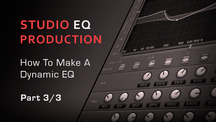Ok, in the both parts before you’ve learned how to set up an EQ with a dynamic behaviour, triggered by an external signal.
Now, we want to overtake the whole procedure to an (pseudo-) internal triggering. That means, the EQ band itself is triggering the amount of change - like a compressor.
To achieve this, we figure out the EQ band we want to change, route the signal to an external track and isolate that band as signal trigger. There’s a clue now: You can’t send the signal from a track to another and route it back - it would generate a feedback loop, which isn’t good for your gear and your ears. Furthermore, Reaper has an built-in feedback-loop detection and if you create such a loop with sends and receives, it will mute the signal out. So wee need to work with subtracks.
For this example: I’ll take the drumloop from the first parts. Let’s say I want to alter the claps, either as upward compression - to make it sound thicker - or with classic downward compression to make it less dominant.
We create the drumloop track in a “Drum Group”. On this “Drum Group” track we’re placing the EQ. Now, we create the “Route Group” and the “Drum Send” subtrack as we did in the second tutorial. Before we turn out the “Master/Parent send”, let us listen to the clap. Place an EQ on the track to isolate the clap sound. Turn the highpass and lowpass filter around the clap frequencies. You recognize, that the kick sound is yet audible with a click. That would trigger our dynamic EQ as well, so let’s blen it out with a simple gate. Reaper has an own simple noisegate plugin, which we will use. Turn up the threshold until just the clap is audible, but not the kick click. Turn off the “Master/Parent Send” option from the “Router Group” track.
Now we can route the triggering signal back to the drumtrack, but in fact to the “Drum Group”, because a send to the drumloop track would create that feedback loop! If you haven’t done yet, create the 3rd and 4th input channel on the “Drum Group” track, route the signal to channel 3 & 4 and enable the parameter modulation.
Like before, enable “Audio signal control“ and set the baseline value above to middle value via doubleclick. Here we need slightly different settings, set attack down to zero and release to 400. If you leave the direction to “positive”, you have now an upward compression, which makes the clap louder and more present, change direction to negative to make the clap more subtle.
Of course, you can create even more dynamic EQ bands. For each band you need to create a send track to isolate the trigger and a pair of input channels at the EQ based track.
*This is a guest post from Lopez who runs the label Electronic Anarchy and is involved in the develpment of Kirnu Cream








